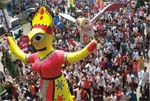Md. Anwarul Kabir
 Following the Bengali calendar when the Pahela Baisakh comes and we step into a New Year, we try to search our souls with a view to rediscovering our cultural heritage originating from this deltaic land mingled with the Bengali ethnicity. On this day, most Bengalis, especially those from the middle class, are engrossed in nostalgia, appreciating the glorious past of our nationhood.
Following the Bengali calendar when the Pahela Baisakh comes and we step into a New Year, we try to search our souls with a view to rediscovering our cultural heritage originating from this deltaic land mingled with the Bengali ethnicity. On this day, most Bengalis, especially those from the middle class, are engrossed in nostalgia, appreciating the glorious past of our nationhood.
Indeed, once upon a time we had a colourful cultural spectrum. Agro-based village society of the land had multi-dimensional cultural aspects. Literally we observed, ‘Baro mashey tero parbon’ (thirteen festivals in twelve months) based on various features of six seasons, religious festivity and other social issues. In secular manner once all Bengalis celebrated many festivals like Nabanna, Poush Mela, Chaitra Sankranti, Eid, Muharram, Durga Puja, Kali Puja and so on. Among these festivals, many were purely secular (e.g. Nabanna, Poush Mela) and some were religious. However, some of the secular festivals have been sent to the museum at the point of history when most of the solvent middle class people were urbanised keeping behind their past peasant roots in remote villages.
In the past, the boundary between religious communities was blurred, especially during festivals. Hindus invited their Muslim friends to their pujas; conversely Hindus also participated as guests in Muslim events and at that time there was no social taboos as we sometime observe in our ‘modern’ time. In those days, no one raised any question whether that particular festival originated from Hindu religion and whether Muslims should be debarred from participation. The reason behind this lay in the way of preaching Islam which began in around the 14th century in this region. Most of the people who were converted into Islam in the erstwhile East Bengal were inspired by the ‘Pir’/’Aulia’ who followed Sufism. This Sufism stressed a spiritual union with God and did not require its newest adherents to abandon their traditional beliefs and practices totally. So, the influence of the indigenous Bengali cultural practices is predominantly evident among the Muslim community in this region. For this, the majority of the Bengali Muslims maintained liberal outlook and traditionally believe in the principle of peaceful coexistence with other religious communities.
Though over time, we have lost some of our traditional festival days, still we can be proud of our addition of Ekushey as a very special day which grew out of love for our mother-tongue Bengali. Language is the most powerful instrument for smooth propagation of cultural heritages from generation to generation. The Bengali language in the recent past has reached such a position where we can confidently assert that this is one of the richest languages of the globe. Bengalis from both Bangladesh and India have promoted Bengali to an extent where we are about to establish Bengali in all aspects of our life, starting from education to other private and public domains.
If we really want to portray ourselves as a self esteemed nation, we must uphold the inherent essence of Bengali nationalism — secularism and the Bengali language. We have a long way to go. Michael Billing, a contemporary sociologist of the UK, in his book entitled “Banal Nationalism” has suggested that if a nation wants to uphold its culture and heritage in the psyche of its people, continuous upholding of the cultural aspects of that nation is a must.
So, if we want to instil our cultural heritage and traditions into the mindset of the people, we need to practise our cultural ethos in our everyday life.
Md. Anwarul Kabir is an educationalist, working at the Computer Science Department of AIUB.
Courtesy of The Daily Star




















